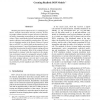Free Online Productivity Tools
i2Speak
i2Symbol
i2OCR
iTex2Img
iWeb2Print
iWeb2Shot
i2Type
iPdf2Split
iPdf2Merge
i2Bopomofo
i2Arabic
i2Style
i2Image
i2PDF
iLatex2Rtf
Sci2ools
MASCOTS
2003
2003
Creating Realistic BGP Models
Modeling the Internet infrastructure is a challenging endeavor. Complex interactions between protocols, increasing traffic volumes and the irregular structure of the Internet lead to demanding requirements for the simulation developer. These requirements include implementation detail, memory efficiency and scalability, among others. We introduce a simulation model of the Border Gateway Protocol that we call BGP++, which is built on the popular ns-2 simulation environment. A novel development approach is presented that incorporates the public domain routing software GNU Zebra in the simulator. Most of the original software functionality is retained, while the transition to the simulation environment required a manageable amount of effort. Moreover, the discussed design inherits much of the maturity of the original software, since the later is only minimally modified. We analyze BGP++ features and highlight its potential to provide significant aid in BGP research and modeling.
MASCOTS 2003 | MASCOTS 2007 | Ns-2 Simulation Environment | Original Software | Simulation Environment |
| Added | 31 Oct 2010 |
| Updated | 31 Oct 2010 |
| Type | Conference |
| Year | 2003 |
| Where | MASCOTS |
| Authors | Xenofontas A. Dimitropoulos, George F. Riley |
Comments (0)

